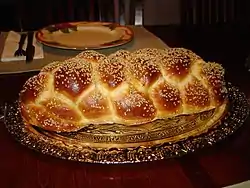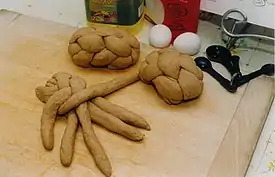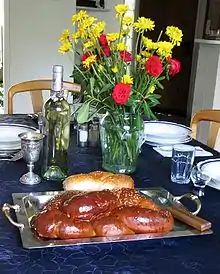Challah
Challah (/ˈxɑːlə/,[1] Hebrew: חַלָּה Halla [χa'la] or [ħa'lɑ]; plural: challot, Challoth or challos) is a special bread in Jewish cuisine, usually braided and typically eaten on ceremonial occasions such as Shabbat and major Jewish holidays (other than Passover). Ritually-acceptable challah is made of dough from which a small portion has been set aside as an offering.
 Challah sprinkled with sesame seeds | |
| Alternative names | Hallah, khala, khale, chałka, kitke, berkhes, barches, bukhte, dacher, koylatch, koilitsh, shtritsl |
|---|---|
| Type | Bread |
| Main ingredients | Eggs, fine white flour, water, yeast, sugar and salt |
The word is Biblical in origin.[2] Similar braided breads – such as kalach, kalács, kolach, or colac – are found in Eastern Europe, though it is not clear whether these influenced or were influenced by the traditional Ashkenazic challah.
Name and origins
The term challah in Biblical Hebrew meant a kind of loaf or cake.[3] The Aramaic word given for its translation is גריצא (pl. גריצן), and which word (var. Syriac ܓܪܝܨܐ / ܓܪܝܣܐ) Payne Smith defines as "a cake or loaf," or "morsel of bread."[4]
In Rabbinic terminology, challah often refers to the portion of dough which must be separated before baking, and set aside as a tithe for the Kohen,[5] since the Biblical verse which commands this practice refers to the separated dough as a "challah".[2] The practice of separating this dough became known as "separating challah" (הפרשת חלה) or "taking challah".[6] The food made from the balance of the dough is also called challah.[7] The obligation applies to any loaf of bread, not only to the Shabbat bread. Nevertheless, "separating challah" may have been more common when baking the Shabbat bread than at other times, because separating challah is only required for large batches of dough (using over 10 cups of flour),[6] such as might be prepared for special occasions.
Variant names
Challah is also now known as cholla bread.[8][9] The bread was adopted by bakers in Poland and the Russian Empire and is known as chałka (diminutive of chała) in Poland and khala (хала) in Belarus, Russia and Ukraine.[10][11]
Yiddish communities in different regions of Europe called the bread khale, berkhes or barches, bukhte, dacher, kitke, koylatch or koilitsh, or shtritsl.[12][13] Some of these names are still in use today, such as kitke in South Africa.[13]
The term koylatch is cognate with the names of similar braided breads which are consumed on special occasions by other cultures outside the Jewish tradition in a number of European cuisines. These are the Russian and Ukrainian kalach, the Serbian kolač, the Hungarian kalács, and the Romanian colac. These names originated from Proto-Slavic kolo meaning "circle", or "wheel", and refer to the circular form of the loaf.[14][15]
Ingredients and preparation

Most traditional Ashkenazi challah recipes use numerous eggs, fine white flour, water, sugar, yeast, oil (such as vegetable or canola), and salt, but "water challah" made without eggs and having a texture not unlike French baguettes also exists. Modern recipes may replace white flour with whole wheat, oat, or spelt flour or sugar with honey or molasses.
Among Sephardic Jews, water challah is preferred for ritual purposes, because Sephardic minhag does not require the dough offering to be separated if the dough contains eggs or sugar. While breads very similar to Ashkenazi egg challah are found in Sephardic cuisine, they are typically not referred to as challah but considered variants of regional breads like çörek, eaten by Jews and non-Jews alike.
Egg challah sometimes also contains raisins and/or saffron. After the first rising, the dough is rolled into rope-shaped pieces which are braided, though local (hands in Lithuania, fish or hands in Tunisia) and seasonal (round, sometimes with a bird's head in the centre) varieties also exist. Poppy or sesame (Ashkenazi) and anise or sesame (Sephardic) seeds may be added to the dough or sprinkled on top. Both egg and water challah are usually brushed with an egg wash before baking to add a golden sheen.
Challah is usually parve (containing neither dairy nor meat—important in the laws of Kashrut), unlike brioche and other enriched European breads, which contain butter or milk.
Israeli challah contains eggs or olive oil in the dough as well as water, sugar, yeast, salt, honey and raisins. It is topped with sesame.
Rituals and religious significance

According to Jewish tradition, the three Sabbath meals (Friday night, Saturday lunch, and Saturday late afternoon) and two holiday meals (one at night and lunch the following day) each begin with two complete loaves of bread.[16] This "double loaf" (in Hebrew: lechem mishneh) commemorates the manna that fell from the heavens when the Israelites wandered in the desert after the Exodus. The manna did not fall on Sabbath or holidays; instead, a double portion would fall the day before the holiday or sabbath to last for both days.[17]
In some customs, each loaf is woven with six strands of dough. Together, the loaves have twelve strands, alluding to the twelve loaves of the showbread offering in the Temple. Other numbers of strands commonly used are three, five and seven. Occasionally twelve are used, referred to as a "Twelve Tribes" challah.
Traditional Sabbath meal procedure

It is customary to begin the evening and day Sabbath and holiday meals with the following sequence of rituals:
- The challah is covered. It is customary to use a dedicated cloth called a challah cover for this purpose, although any improvised cover is acceptable.
Something, often what is called a Challah board, is under the Challah, although a simple napkin is acceptable if nothing else is available. The "under" and "covering" are to remind of the dew that fell, before and after the manna. It also serves as a cutting board for slicing the Challah.
(Another reason for the cover is that normally, in the order of saying blessings, the challah would precede the wine; we therefore cover the challah's presence.)
- Kiddush is recited over a cup of wine.
- Each attendee ritually washes their hands in preparation for eating bread. (It is customary not to talk between this washing and consumption of the bread.[18])
- The challah cover is removed.
- A nick is made in the bread with a cutting knife.
- The two loaves are held up together.
- The head of the household recites the blessing over bread: "Baruch atah Adonai, eloheinu melech ha'olam, hamotzi lechem (Le Khemekh) min ha'aretz" (Translation: "Blessed are you LORD our God, King of the Universe, who brings forth bread from the earth").
- The bread is sliced (or torn, depending on minhag) and salted, and the pieces are distributed to each person at the meal to eat.
The specific practice varies. Some dip the bread into salt before the blessing on bread.[19] Others say the blessing, cut or tear the challah into pieces, and only then dip the pieces in salt, or sprinkle them with salt, before they are eaten.[20]
Normally, the custom is not to talk between washing hands and eating bread. However, according to some, if salt was not placed on the table, it is permitted to ask for someone to bring salt, before the blessing on bread is recited.[21]
Salting
Salting challah is considered a critical component of the meal. Customs vary whether the challah is dipped in salt, salt is sprinkled on it, or salt is merely present on the table.
The Torah requires that Temple sacrifices to God be offered with salt.[22] Following the destruction of the Second Temple, Rabbinic literature suggested that a table set for a meal symbolically replaces the Temple altar; therefore, the blessing over food should only be recited with salt present on the table.[18] Should one eat a meal without performing a commandment, the covenant of salt protects him.[23]
To the rabbis, a meal without salt was considered no meal.[24] Furthermore, in the Torah, salt symbolizes the eternal covenant between God and Israel.[25] As a preservative, salt never spoils or decays, signifying the immortality of this bond.[26]
Special challah
Rosh Hashanah
On Rosh Hashanah, the Jewish New Year, the challah may be rolled into a circular shape (sometimes referred to as a "turban challah"), symbolizing the cycle of the year, and is sometimes baked with raisins in the dough. Some have the custom of continuing to eat circular challah from Rosh Hashana through the holiday of Sukkot.
Sometimes the top is brushed with honey to symbolize the "sweet new year." According to some traditions, challah eaten on Rosh Hashana is not dipped in or sprinkled with salt but instead is dipped in or sprinkled with honey. As above, some continue to use honey instead of salt through the Sukkot holiday.[27]

Shlissel challah
For the Shabbat Mevarchim preceding Rosh Chodesh Iyar (i.e., first Shabbat after the end of Passover), some Ashkenazi Jews have the custom of baking shlissel[28] challah ("key challah") as a segula (propitious sign) for parnassa (livelihood). Some make an impression of a key on top of the challah before baking, some place a key-shaped piece of dough on top of the challah before baking, and some bake an actual key inside the challah.[29]
The earliest written source for this custom is the sefer Ohev Yisrael by Rabbi Avraham Yehoshua Heshel, the Apter Rav, written in the 1800s. He calls schlissel challah "an ancient custom," and offers several kabbalistic interpretations. He writes that after spending forty years in the desert, the Israelites continued to eat the manna until they brought the Omer offering on the second day of Passover. From that day on, they no longer ate manna, but food that had grown in the Land of Israel. Since they now had to start worrying about their sustenance rather than having it handed to them each morning, the key on the challah is a form of prayer to God to open up the gates of livelihood.[29]
The custom has been criticized for allegedly having its source in Christian or pagan practices.[30]
Challah rolls
Shabbat challah, known as a bilkele or bulkele or bilkel or bulkel (plural: bilkelekh; Yiddish: בילקעלע) baigiel (Polish) is a bread roll made with eggs, similar to a challah bun. It is often used as the bread for Shabbat or holiday meals.
Similar breads
Similar braided, egg-enriched breads are made in other traditions. The Polish chałka is similar, though sweeter than challah. The Czech and Slovak vánočka is very similar and traditionally eaten at Christmas. In Bulgarian and Romanian cuisine there is a similar bread called cozonac (Bulgarian: козонак), while tsoureki bread (also known as choreg or çörek) is popular in Armenian,[31] Greek and Turkish cuisines. Zopf is a similar bread from Germany, Austria and Switzerland, with a sweeter variant known as Hefezopf or Hefekranz. In Finnish cuisine, pulla (also known as cardamom bread in English) is a small braided pastry seasoned with cardamom that is very popular in Finnish cafés. Brioche is an egg-enriched bread, but it is not braided.
Unlike challah, which by convention is pareve, many of these breads also contain butter and milk.
See also
| Wikibooks Cookbook has a recipe/module on |
| Wikimedia Commons has media related to Challah. |
- Challa (disambiguation page)
- Israeli cuisine
- Jewish cuisine
- Kashrut
- Shabbat
- Terumah
References
- "challah". Merriam-Webster Dictionary. Retrieved 10 April 2020.
- Numbers 15:20
- "Strong's Concordance".
- Payne Smith, J. (1903). A compendious Syriac Dictionary: founded upon the Thesaurus Syriacus of R. Payne Smith (in Syriac and English). Oxford: Clarendon Press. p. 78. OCLC 251355373.
- Jastrow, חַלָּה (meaning 2)
- "Ask the Expert: Taking Challah". MyJewishLearning.com.
What does it mean to take challah
- "AlHatorah Concordance-Dictionary, s.v. חַלָּה".
- Arnold E. Bender. Dictionary of Nutrition and Food Technology (4th ed.). London: Newnes-Butterworths. p. 54. ISBN 0-408-001437.
- "Loaves For Jewish Festivals "Not Bread"". The London Times (55124). London. 4 July 1961. p. 8.
- Леонид Беловинский (2015). "Хала". Энциклопедический словарь истории советской повседневной жизни (in Russian). Новое Литературное Обозрение. ISBN 978-5444803783.
- Barbara Rolek. Polish Egg-Twist Bread Chalka Recipe. The Spruce, 2017.
- Come ’Round. Forward.com, 2004.
- South African Challah?. Forward.com, 2005. The etymology of kittke is given as Kitt + -ke: Kitt in German means "putty" ; "-ke" is the Slavic diminutive suffix found in many Yiddish words and names. Kitke referred not to the whole challah but simply to the braids or decorations that were attached to the challah like putty before baking, and the word must have originally referred to these.
- Colac (in Romanian). DEXOnline: Dictionar Explicativ al Limbii Romane (Romanian online dictionary). References: Miklosich, Slaw. Elem., 25; Cihac, II, 67; Conev 66
- Колач (in Russian). Max Vasmer. Russisches etymologisches Wörterbuch. Winter, Heidelberg 1953–1958 (in German). Russian translation by Oleg Trubachyov: Этимологический словарь русского языка. Progress, Moscow, 1964–1973.
- Maimonides (d. 1204), Mishneh Torah Hilchot Shabbos, Chapter 30, Law 9. (Hebrew)
- Sol Scharfstein, Understanding Jewish Holidays and Customs, page 16 (1999)
- "Salt". Jewish Encyclopedia. Retrieved 7 March 2013.
- Isserles, in Shulcḥan 'Aruch, l.c.
- Both practices are based on different parts of the same verse in Leviticus
- Shulchan Aruch, Oraḥ Ḥayyim 167:5; Jacob Zausmer, "Bet Ya'aḳob," No. 168; comp. Berachot 40a.
- Leviticus 2:13
- Tosafot, Berachot 40a
- Berachot 44a
- Silberberg, Naftali. "Why is the Challah dipped in Salt". Chabad.org. Retrieved 7 March 2013.
- Rabinowitz, Louis Isaac. "Salt". Encyclopedia Judaica.
- some keep the salt on the table, to not "withhold" salt from being present, per Lev. 2:13
- or schlissel
- "Second Thoughts: The Key to Parnassah." Hamodia, Feature Section, p. C3. 23 April 2009.
- Shelomo Alfassa, Shlissel Challah – “The Loaf of Idolatry?”
- "Adventures in Armenian Cooking". St. Sarkis. Archived from the original on 21 May 2008.